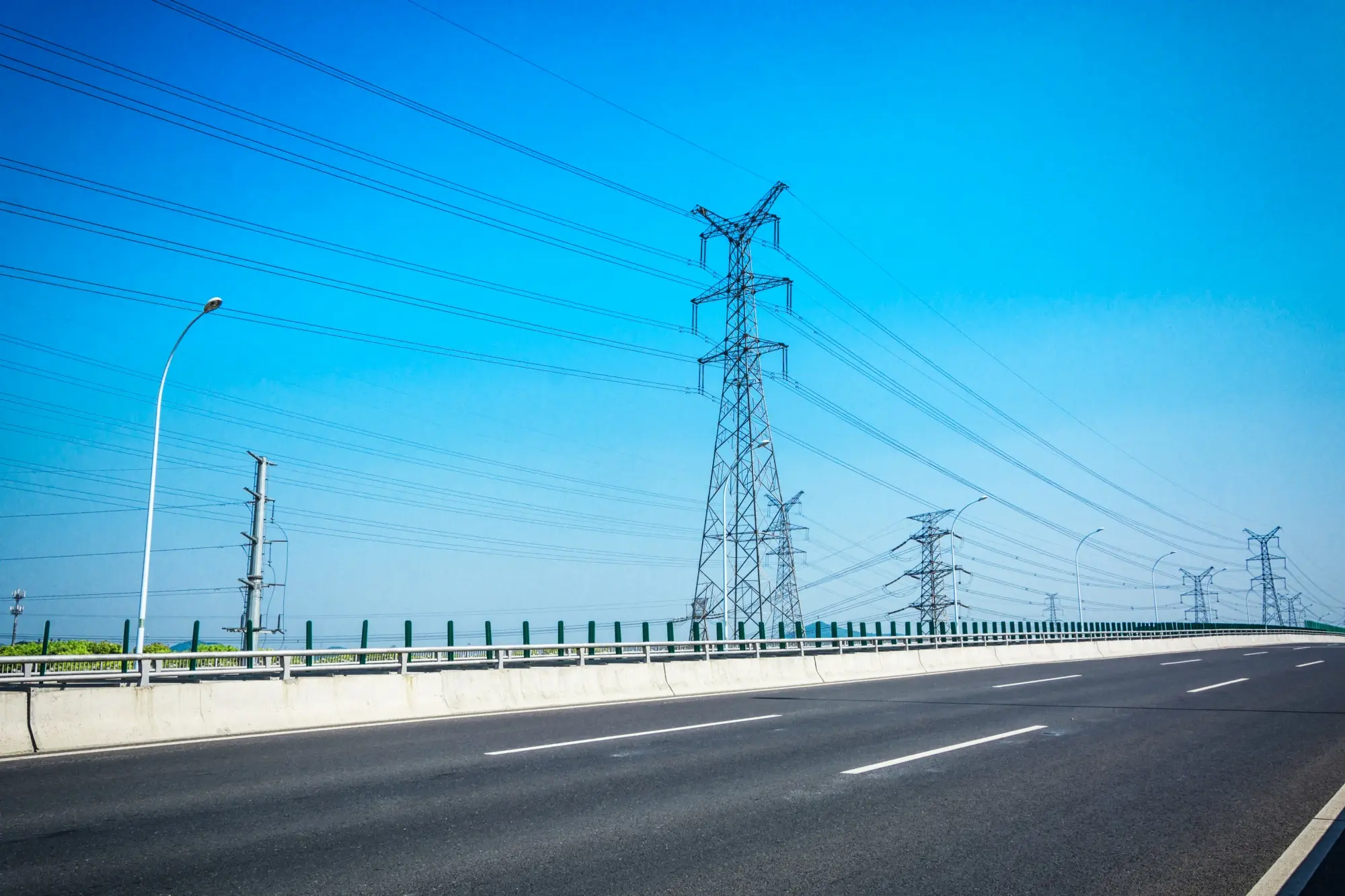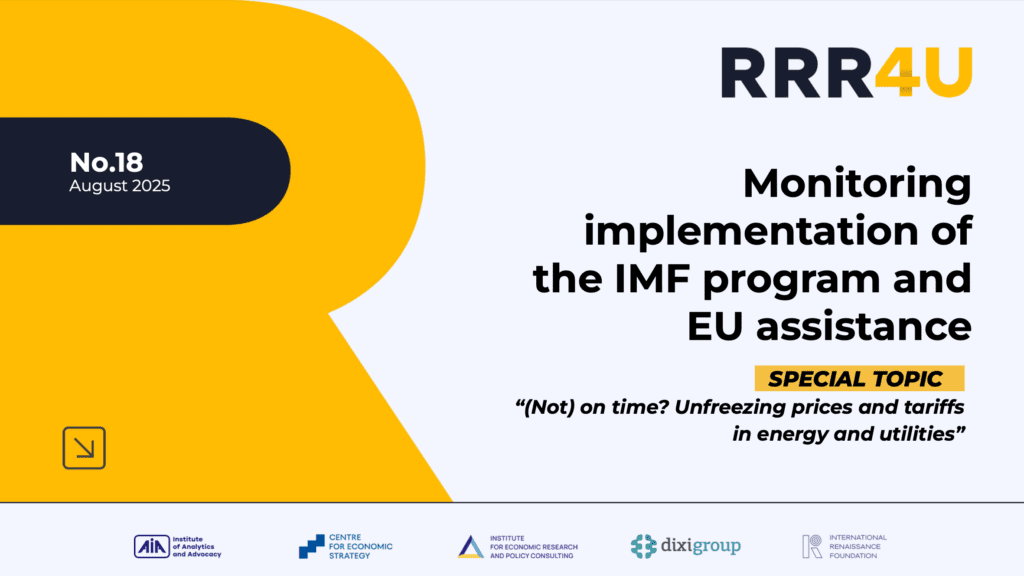
After the July scandal with anti-corruption bodies, the Ukrainian authorities abruptly shifted their stance and resumed fulfilling their commitments. President Zelensky stressed that fighting corruption and moving towards the EU must remain priorities. The government also finally appointed the head of the Bureau of Economic Security (BES). All this became an important signal to European partners and a way to preserve Ukraine’s joint path to the EU together with Moldova.
Talks about a new cooperation programme with the IMF are ongoing, though there are no official details yet. The main problem is that the current agreement assumed a quick end to the war and the start of reconstruction, but those forecasts did not come true. It is expected that Ukraine’s unfulfilled obligations will be carried over into the new programme, while the IMF itself may be more demanding of the Ukrainian authorities.
The government updated Ukraine’s Plan for the Ukraine Facility and agreed on changes with the European Commission. Some reforms were decided to be accelerated, in particular the sale of state-owned banks and changes in the energy sector. The EU Council is expected to approve the updated Plan by the end of September, and in that case, starting from Q3 2025 Ukraine will report according to the new schedule. In this presentation we use the version of the Ukraine Plan valid as of August, which does not yet reflect these changes.
IMF
The ninth review of the IMF program is expected to take place in November–December. The fulfilment of quantitative performance criteria and structural benchmarks as of the end of September 2025 will be assessed. In total, the authorities must fulfil nine structural benchmarks by the end of September.
At the same time, according to RBC-Ukraine, as of August 11, 2025, the IMF mission will already be working at the end of August. In particular, the issue of either revising the program in December or concluding a new program will be discussed.
There are no official details yet, but there is a high probability that we will see a new program with the IMF by the end of the year. Some of the unfulfilled structural benchmarks from the current program may be included in the new program with the IMF.
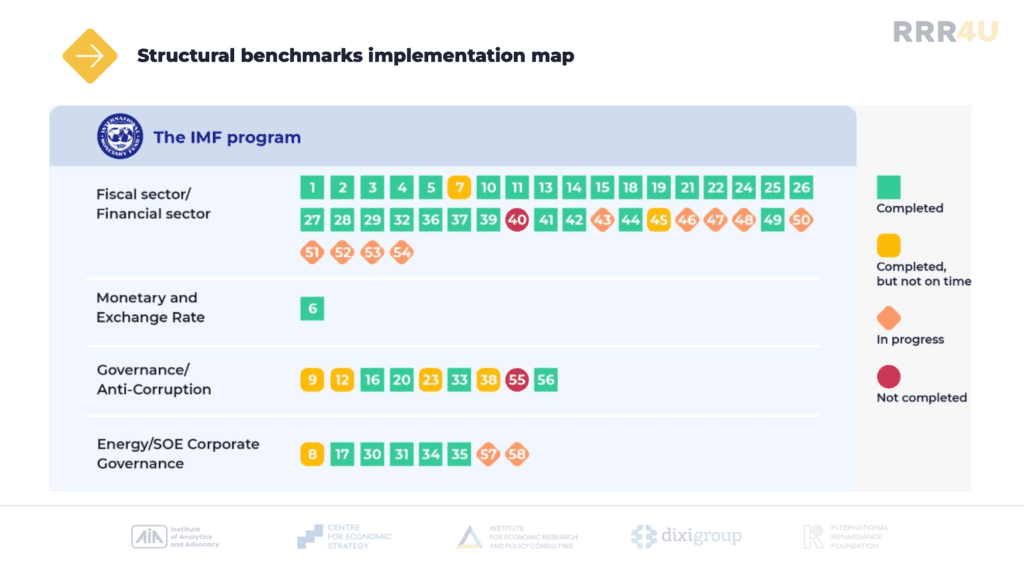
EU
The implementation of the Ukraine Plan is ongoing under the Ukraine Facility.
Only on August 22, Ukraine received a tranche from the EU for fulfilling the indicators of the first quarter: EUR 3.05 bn instead of the planned EUR 4.48 bn as three indicators were not met at the moment of reporting.
2 indicators of the first quarter and 3 indicators of the second quarter have not yet been met. But, on August 27, the government launched transparent international tenders for concluding production sharing agreements, and the Parliament approved the draft law on Vocational Education, which is the President’s signature.
The government will most likely submit a report to the European Commission on the implementation of indicators for the second quarter in the first week of September – again, the money will come later.
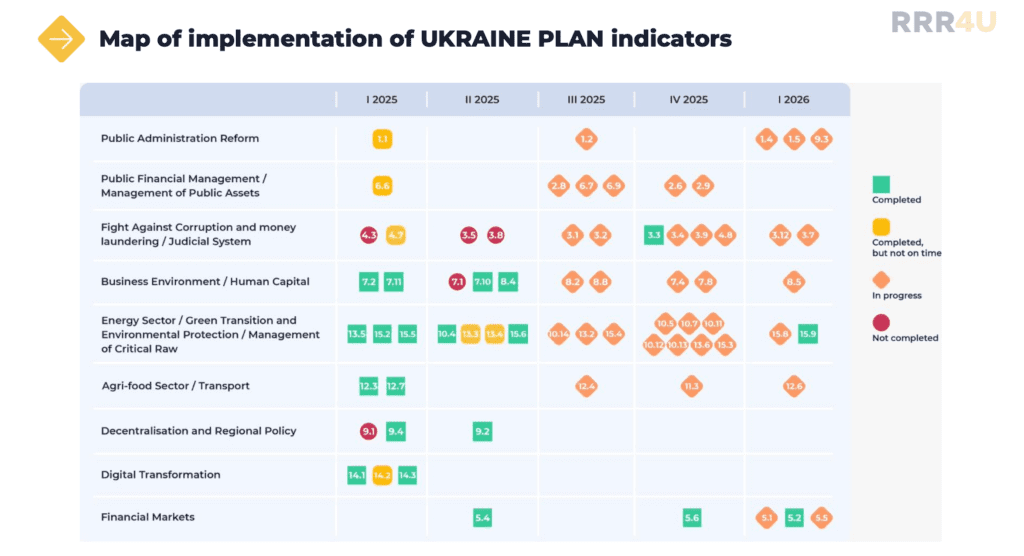


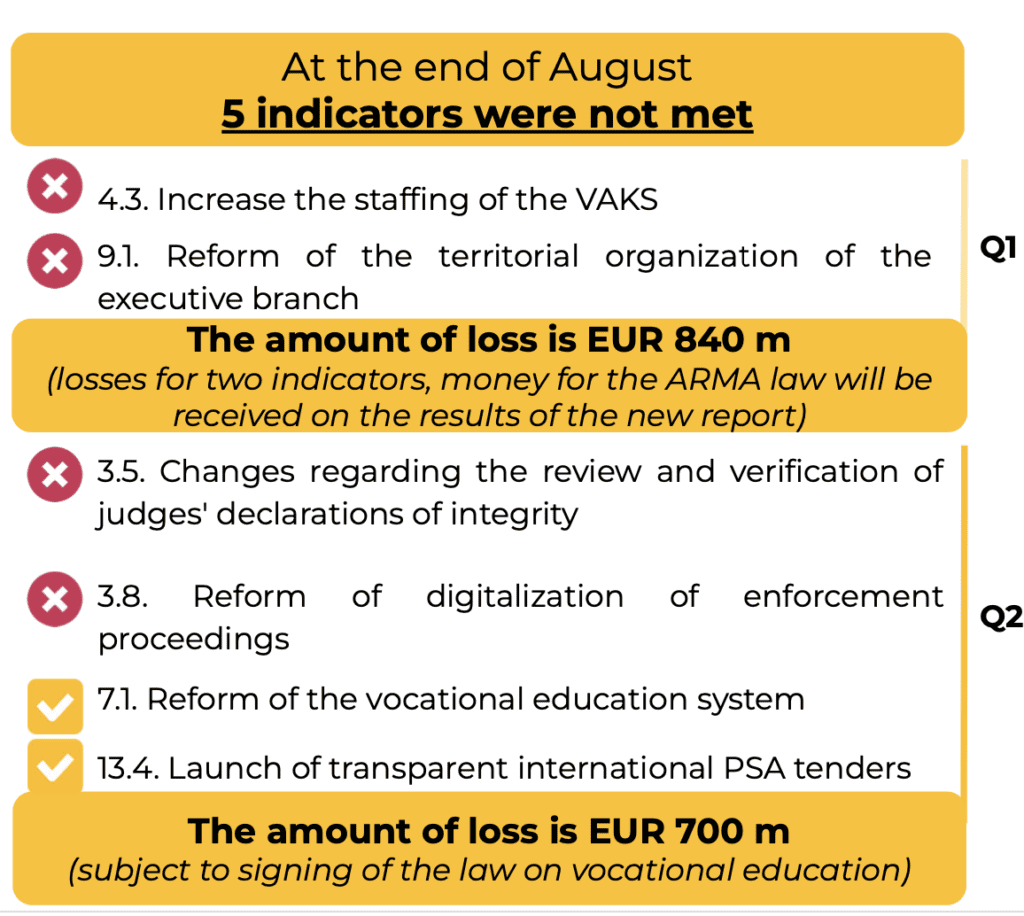


Meanwhile, the Government has made changes to Ukraine Plan
- On August 1, the Cabinet of Ministers made amendments to Ukraine Plan, as provided for by the Ukraine Facility rules.
- The relevant changes must be approved by the European Commission and the EU Council (which is expected by the end of September).
- Three indicators were brought forward
- Law on the sale of state-owned banks – moved from Q1 2026 to Q3 2025 (completed)
- National Waste Management Plan – moved from Q1 2026 to Q3 2025 (already completed)
- Law for the Electricity Integration Package – moved from Q4 to Q3 2025 (passed first reading)
- Two indicators were split into several with different implementation timelines
- Creation of a new court for administrative cases = Law on the establishment of the Specialized District Administrative Court and the Specialized Administrative Court of Appeal, start of transparent selection of judges in Q3 2025 + establishment of the new court for administrative cases in Q4 2025
- Railway Transport Law = Law on Railway Traffic Safety and Interoperability in Q4 2025 + Law on the Railway Transport Market in Q4 2026
- Eleven indicators were postponed
Moratorium – applies only to the population
- Law No. 2479-IX prohibits, for the period of martial law (+6 months after), any increase in tariffs for:
- natural gas distribution services;
- thermal energy (its production, transportation and supply);
- thermal energy and hot water supply services.
- …as well as a revision towards an increase in natural gas prices for household consumers, condominiums/housing complexes (boiler houses)
- “Fixed” plan from Naftogaz (99.9% of the population) 7.96 UAH/m3 extended until 04/30/2026
- 06/30/2023 canceled in part of tariffs for heat and hot water for non-domestic consumers
- On June 4, 2024, tariffs for gas distribution for non-household consumers (enterprises, budget institutions, heat supply organizations, municipal facilities) were canceled.
- By resolution No. 502 of April 29, 2022, the CMU “recommended” the application of the 2022 tariffs for centralized water supply/wastewater disposal
In addition to the moratorium, there are public service obligations (PSOs) in place, which set regulated prices/tariffs on the markets:
Electricity (CMU Resolution No. 483 of June 5, 2019 as amended)
- households, dormitories, IDPs, religious organizations: 4.32 UAH/kWh (night tariff 2.16 UAH/kWh) until 31.10.2025
- supplier of last resort (SoLR): tariff 0.00 UAH/MWh until 31.12.2025
- participants: universal service suppliers (USSs), Guaranteed Buyer, Energoatom, Ukrhydroenergo; for SoLR – Ukrenergo
- on October 28, 2022, cancelled in the part related to DSOs’ technological losses; on June 1, 2024, household electricity prices increased by 63.6%.
Gas (CMU Resolution No. 222 of March 6, 2022 as amended)
- households, gas distribution system operators (technological consumption/losses*), supplier of last resort (SoLR)
- electricity producers using natural gas (as per the Ministry of Energy list): 14 or 18 UAH/m 3
- participants: Naftogaz Group companies, including extraction enterprises
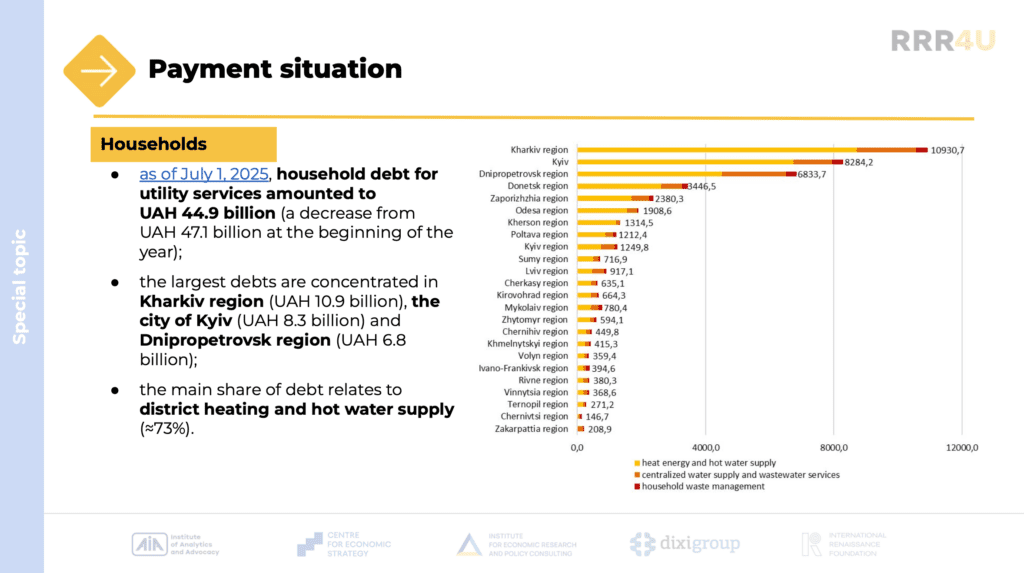


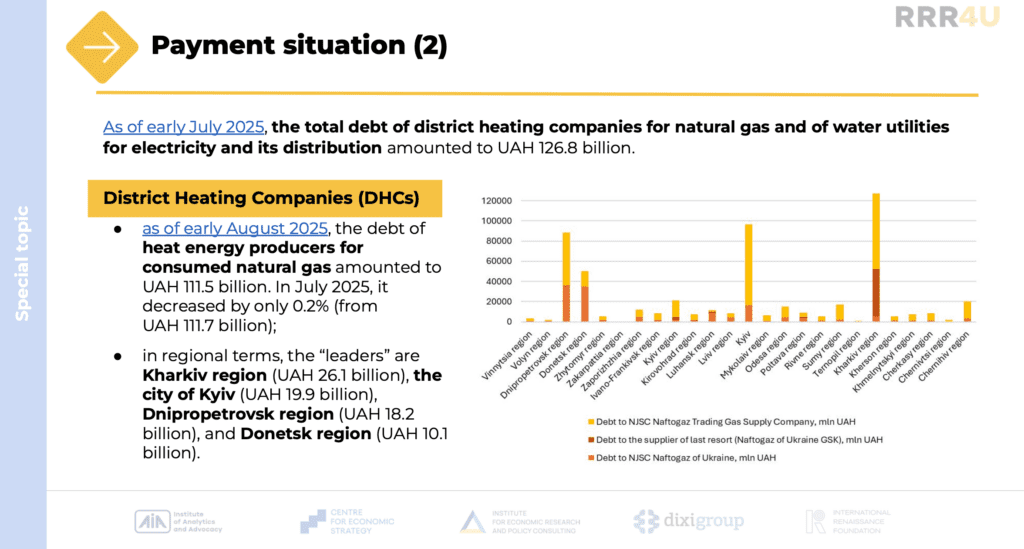


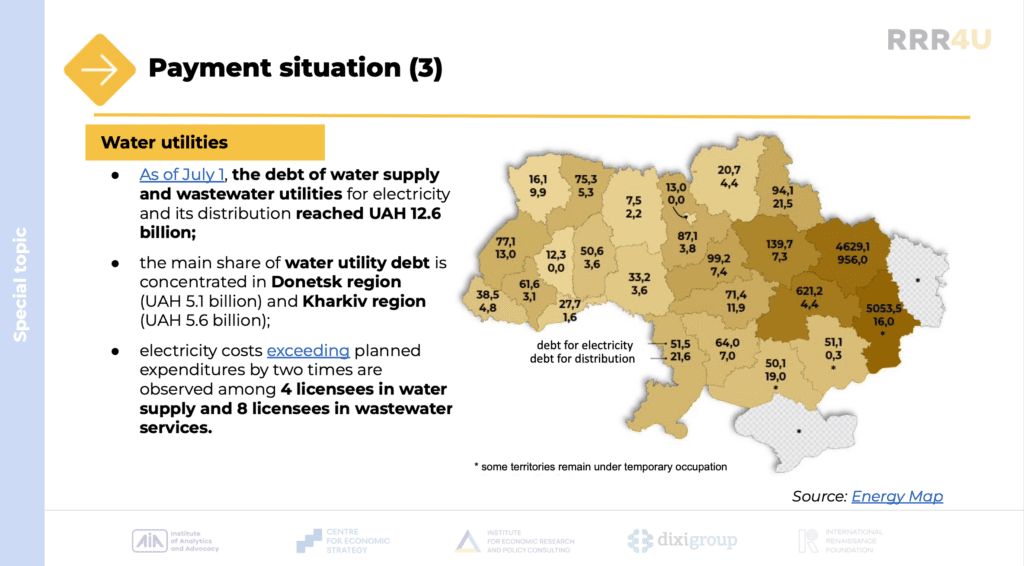


Obligation
IMF program
- Ukraine has within six months after the end of martial law.
- This includes a phased increase in tariffs to restore the sector’s financial sustainability and stimulate competition, while at the same time improving the housing utility subsidy system to ensure social protection.
- A comprehensive settlement of DHCs debts is envisaged once the wartime burden on the state budget decreases, through the development of a new tariff methodology that reflects actual costs.
Ukraine Facility
- Indicator 10.12 Lifting the moratorium on increasing tariffs for heat and hot water (Q4 2025) – the government’s proposal to postpone to Q4 2026.
- Indicator 10.9 Adoption of the Roadmap for the gradual liberalization of the gas and electricity market, to be implemented after the end of martial law (Q2 2026)

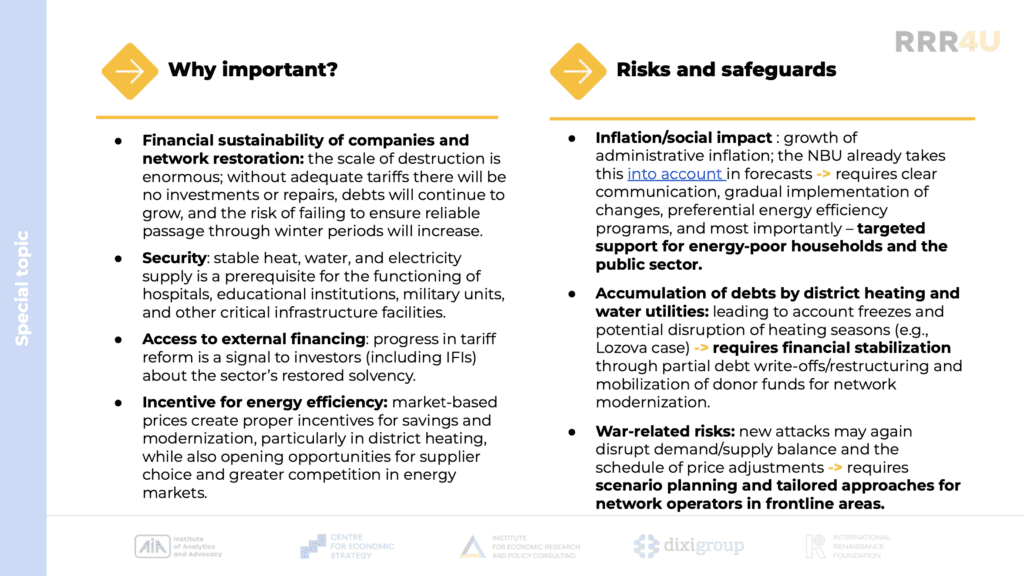

You can view the previous monitors on the website RRR4U
The monitoring was prepared with the support of the International Renaissance Foundation.
RRR4U (Resilience, Reconstruction and Relief for Ukraine) is a consortium of four Ukrainian civil society organisations: Centre for Economic Strategy, Institute for Economic Research and Policy Consulting, Institute of Analytics and Advocacy and DiXi Group.
